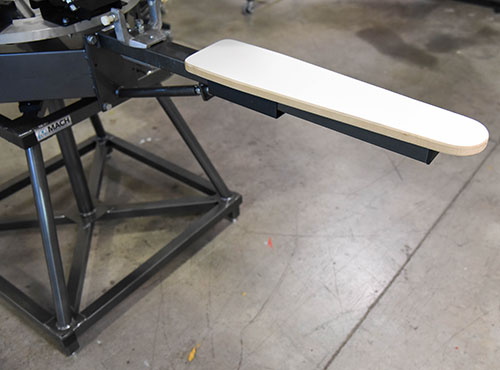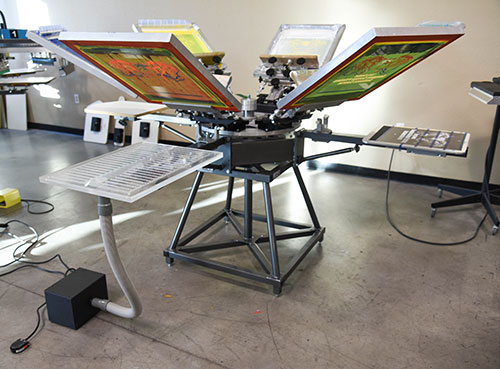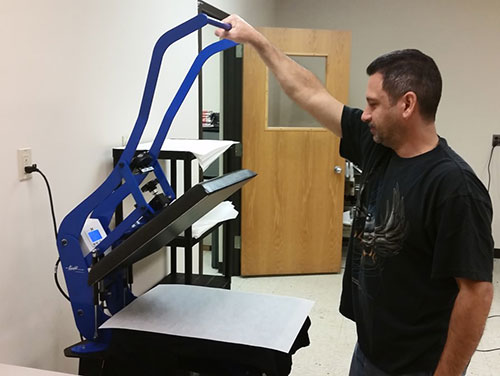Strategy April 26, 2018
Expand Your Offerings With Specialty Platens
Printing on the front and back of T-shirts is a screen printer’s bread and butter. But with specialized platens, you can expand your decorating options to the sleeve and beyond.

A sleeve platen on your press will give you a variety of print location options. Photo courtesy Workhorse Products.
Sleeve platen: A sleeve platen is commonly about 16 inches long and 5 inches wide, allowing you to print on both long- and short-sleeved garments.
Here’s a suggestion for printing sleeves: Always have your own logo and phone number ready to print on short sleeves (using your sleeve platen), and offer a free one-color setup if you can add your logo to your customer’s garment. Most groups (outside of retail) will quickly agree and you have an inexpensive promotion on the sleeves of your customer’s shirts.
Sleeve platens aren’t just for arms. You can use them to print on the leg of sweatpants or shorts. They’re also a great solution when you want to remove a collar tag and replace it with a screen-printed label either on the inside or outside of the shirt. Be sure you have all the legal requirements for garment labeling included in your printed label, however.
Youth and infant platen: It would be difficult to be a decorator without the ability to print youth garments. For this, you need a set of 10-inch-by-12-inch platens in your inventory. If you want to print on onesies, there are even smaller platen sizes available from most printer manufacturers or from third-party platen manufacturers.
Jacket hold-down platen: No amount of adhesive will hold a lined jacket in place for printing. If you opt to print jackets, you’ll need a jacket hold-down platen. This platen looks like a standard adult platen, but with a hinged clamp hoop attached. After loading the jacket, the clamp is lowered to hold the jacket in place for printing
Here’s a tip for better jacket printing: After loading the jacket, put it under your flash unit for about five seconds. This will cause the nylon to shrink just a bit and give you a very tight surface to print on. Remember, if you’re printing more than one color, you’ll need to flash between each color, unlike your normal wet-on-wet process.

A vacuum platen allows you to use your press for plastisol heat transfers, and then apply these transfers to garments and hats as well. Photo courtesy Workhorse Products.
Vacuum platen: Printing plastisol transfers gives you the ability to prepare a quantity of images without tying up printed garment inventory. If you’re going on the road to a sports tournament or other off-site event, your inventory is an inexpensive transfer and blank shirts. You’ll heat apply these transfers to order at the event.
Your ink supplier will likely be able to provide you with transfer paper as well. Place the transfer paper on the vacuum platen, place your foot on the pedal to activate the vacuum, and print the transfer. Why is a vacuum necessary when you could use an adhesive instead? When you stack the transfers after drying, residual adhesive would pull the ink off the transfer sheet below. The only safe way to stack transfers is when the paper has been vacuumed to the platen for printing.
After printing (as a reverse image), transfers are run through your dryer belt and dried to the touch, but not cured. For multicolor prints, you’ll print each color, run down the belt, realign on the vacuum platen and add the next color. You’ll print in reverse order of what you would normally print directly on the garment.

A heat press is an essential piece of equipment in any screen printing shop. Photo courtesy Equipment Zone.
You’ll use a heat press for applying the transfers. That same heat press can be used for names and numbers in team printing, as well as cut vinyl images, rhinestones and other value-added applications.
***
Terry Combs is a 35-plus-year veteran of the garment-printing industry and has managed production shops across the United States. He is currently in sales and training with Equipment Zone, Franklin Lakes, NJ, working from Scottsdale, AZ.
